This set of Linear Integrated Circuit Problems focuses on “Summing, Scaling & Averaging Amplifier – 2”.
1. Which type of amplifier has output voltage equal to the average of all input voltages?
a) Inverting averaging amplifier
b) Non-inverting averaging amplifier
c) Non-inverting summing amplifier
d) Inverting scaling amplifier
View Answer
Explanation: In non-inverting averaging amplifier, the non-inverting input voltage is the average of all inputs, with a positive sign.
2. Expression for output voltage of non-inverting summing amplifier with five input voltage?
a) Vo = 5×( Va + Vb+ Vc+ Vd+ Ve)
b) Vo = [1+( Rf/R1)]× ( Va + Vb+ Vc+ Vd+ Ve)
c) Vo = Va + Vb+ Vc+ Vd+ Ve
d) Vo = ( Va + Vb+ Vc+ Vd+ Ve) /5
View Answer
Explanation: The output voltage of non-inverting summing amplifier is (1+ ( Rf / R1 )) times the average of all input voltages in the circuit.
Since there are five input voltages => (1+ ( Rf / R1 )) =5
Therefore, Vo = 5×( Va + Vb+ Vc+ Vd+ Ve) /5
=> Vo = (Va + Vb+ Vc+ Vd+ Ve).
3. Find the value of V1 in the circuit shown below?
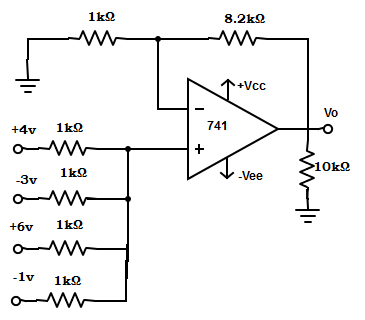
a) 4v
b) 2v
c) 3v
d) None of the mentioned
View Answer
Explanation: Using the superposition theorem the voltage V1 at non-inverting terminal is V1 = Va/4 + Vb/4+ Vc/4+ Vd/4 = [Va + Vb+ Vc+ Vd] /4 = [4+(-3v)+6v+(-1v) ] /4 = 1.5v.
4. If the gain of a non-inverting averaging amplifier is one, determine the input voltages if the output voltage, if the output voltage is 3v?
a) V1 =6v ,V2=3v and V3=2v
b) V1 =9v ,V2=5v and V3=-4v
c) V1 =8v ,V2=-6v and V3=1v
d) V1 =7v ,V2=4v and V3=-3v
View Answer
Explanation: As the output voltage = Average of all input voltage = sum of input voltage /3
∴ sum of input voltage =3×3=9.
From the given option, the combination of input voltage 7v, 4v and -3v gives the value 9v.
5. In the circuit shown, supply voltage = ±15v, Va= +3v , Vb= -4v , Vc= +5v, R= R1= 1kΩ and RF= 2kΩ. 741 op-amp has A= 2×105 and R1= 10kΩ. Determine the output voltage internal resistance of the circuit?
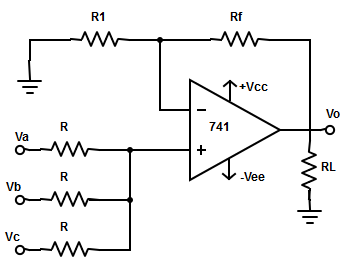
a) Vo ≅3v , RiF=6.67MΩ
b) Vo ≅3v , RiF= 7MΩ
c) Vo ≅3v , RiF=9.2MΩ
d) Vo ≅3v , RiF= 3.5MΩ
View Answer
Explanation: The output voltage Vo= [1 + (RF/R1)] × [ (Va+Vb+Vc/3)] = [1+(2kΩ/1kΩ)] ×[(3-4+5)/3]= 2.67 ≅ 3v.
Internal resistance of circuit, RiF =R i [A×R1/ (R1+ RF)] = 100Ω×[(200000×1kΩ)/(1kΩ+2kΩ)] => RiF= 6.67 MΩ.
6. Find the type of amplifier that cannot be constructed in differential configuration?
a) Summing amplifier
b) Scaling amplifier
c) Averaging amplifier
d) Subtractor
View Answer
Explanation: In differential op-amp configuration, an amplifier produces sum or difference between two input terminals of op-amp. So, averaging is not possible in this type of configuration.
7. Calculate the output voltage, when a voltage of 12mv is applied to the non-inverting terminal and 7mv is applied to inverting terminal of a subtractor.
a) 19mv
b) 5mv
c) 1.7mv
d) 8.4mv
View Answer
Explanation: Output voltage of a subtractor Vo = Vnon-inverting terminal – Vinverting terminal = 12mv-7mv =5mv.
8. Find the differential amplifier configured as a subtractor from the given circuit.
a)
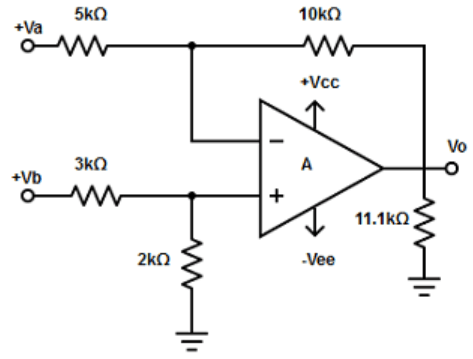
b)
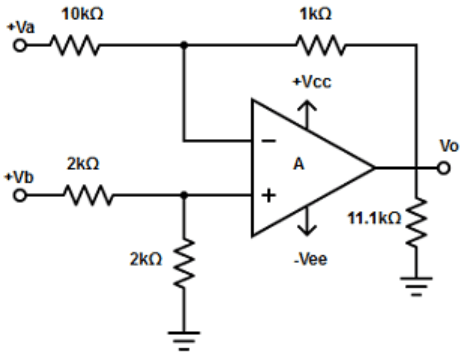
c)
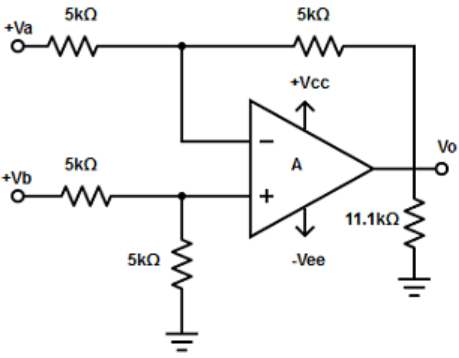
d)
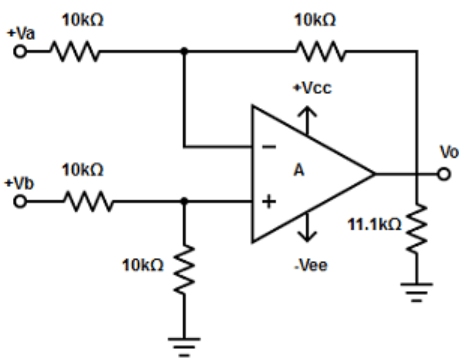
View Answer
Explanation: A basic differential amplifier is used as a subtractor when all the external resistors are equal in value.
The output voltage, Vo= -(R/R)×(Va -Vb)
Vo= (Va -Vb). Hence the circuit is called as subtractor.
9. How many additional sources are connected to each input terminal to obtain an eight input summing amplifier?
a) Six
b) Three
c) Four
d) Eight
View Answer
Explanation: An eight input summing amplifier can be constructed using basic differential amplifier, if six additional input sources are used by connecting three input sources to inverting and non-inverting input terminal through resistors.
10. Calculate the output voltage for the summing amplifier given below, where R=2kΩ and RL =10kΩ.
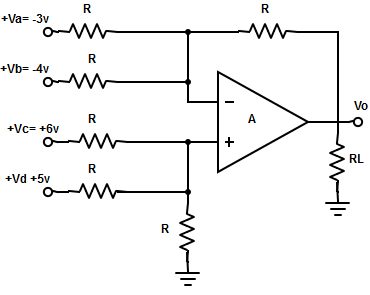
a) 4v
b) 18v
c) 8v
d) None of the mentioned
View Answer
Explanation: The output voltage for summing amplifier is given Vo =-Va -Vb +Vc +Vd =3-4+6+5 =4v.
11. The output voltage of a summing amplifier is equal to (assume sum of input voltage as Vn )
a) Vn (non-inverting terminal)+ Vn (inverting terminal)
b) Vn (non-inverting terminal)+ (-Vn (inverting terminal)
c) -Vn (non-inverting terminal)+ (-Vn (inverting terminal)
d) -Vn (non-inverting terminal)+ Vn (inverting terminal)
View Answer
Explanation: The output voltage of summing amplifier is equal to sum of the input voltage applied to the non-inverting terminal plus the negative sum of the input voltage applied to the inverting terminal.
Sanfoundry Global Education & Learning Series – Linear Integrated Circuits.
To practice all areas of Linear Integrated Circuit Problems, here is complete set of 1000+ Multiple Choice Questions and Answers.
If you find a mistake in question / option / answer, kindly take a screenshot and email to [email protected]
